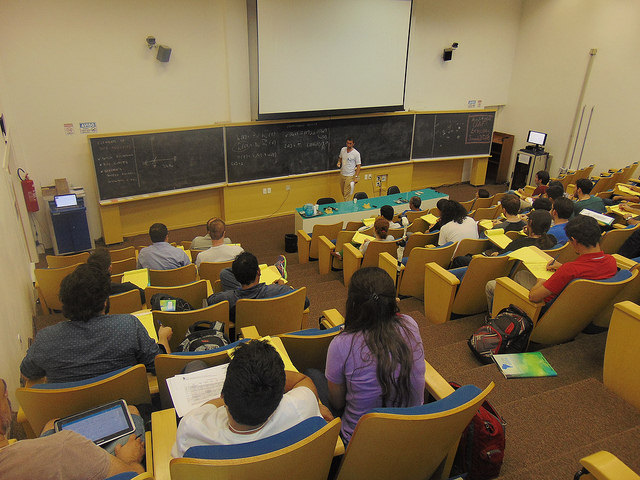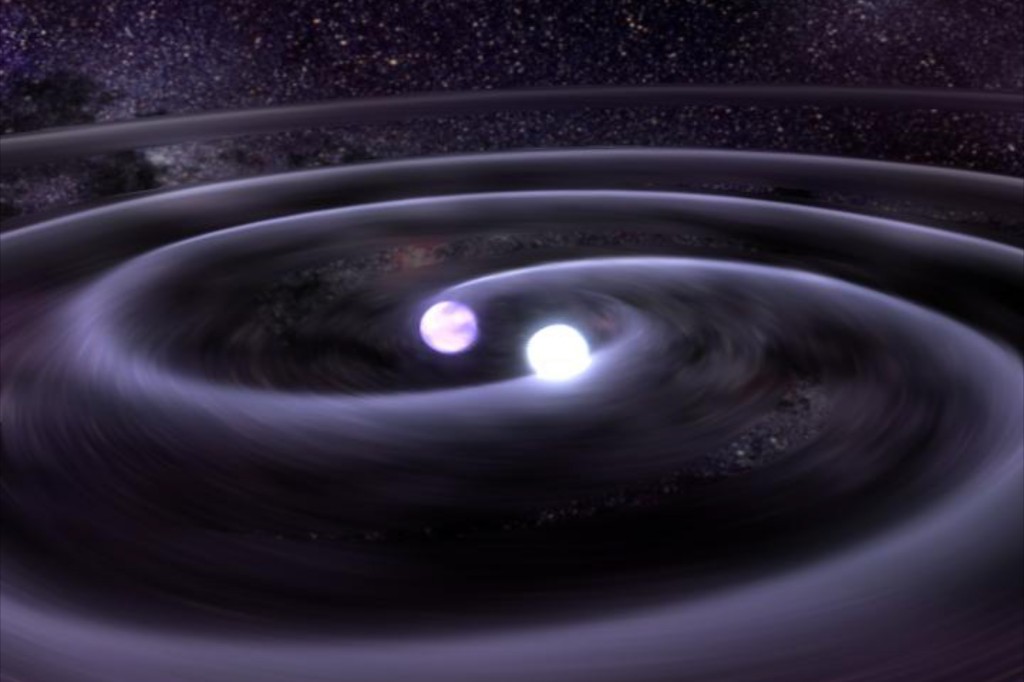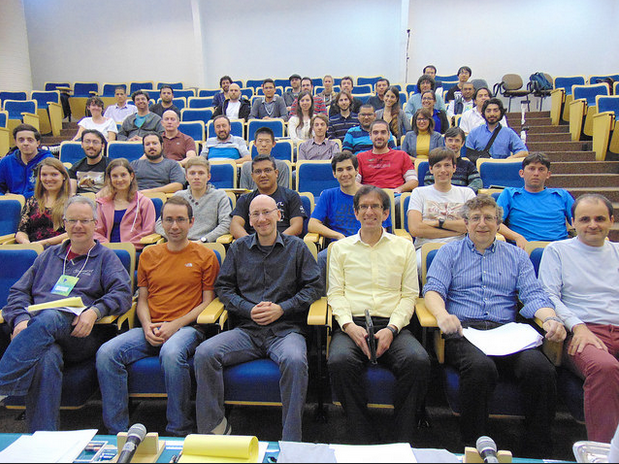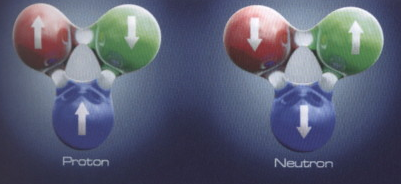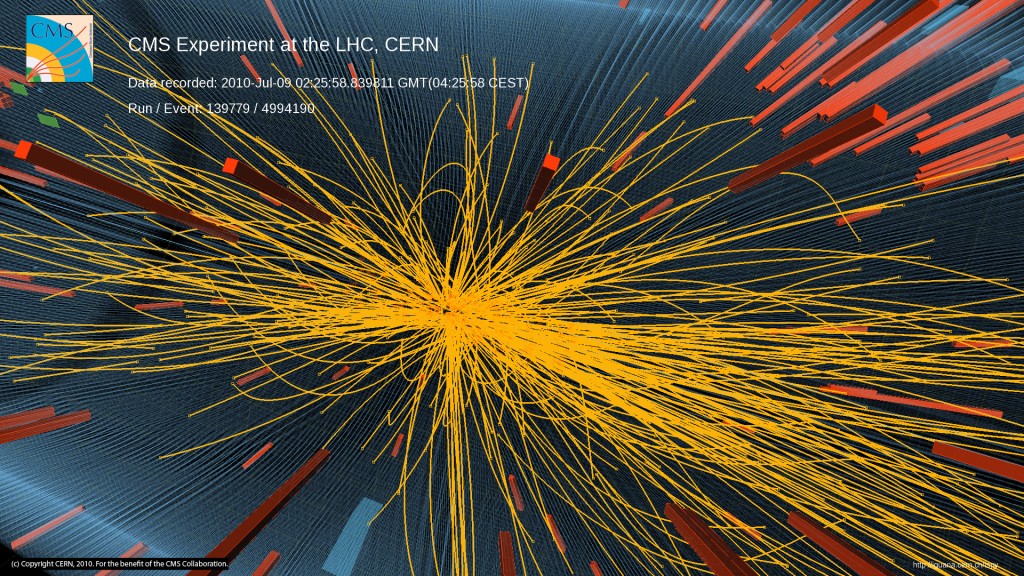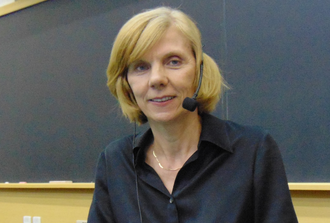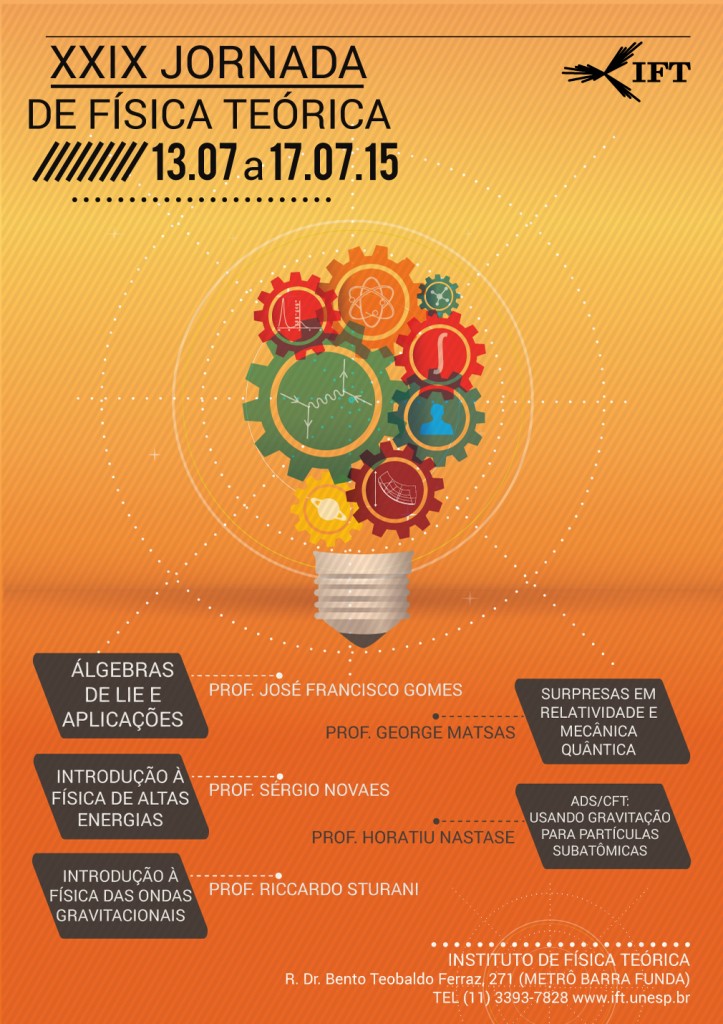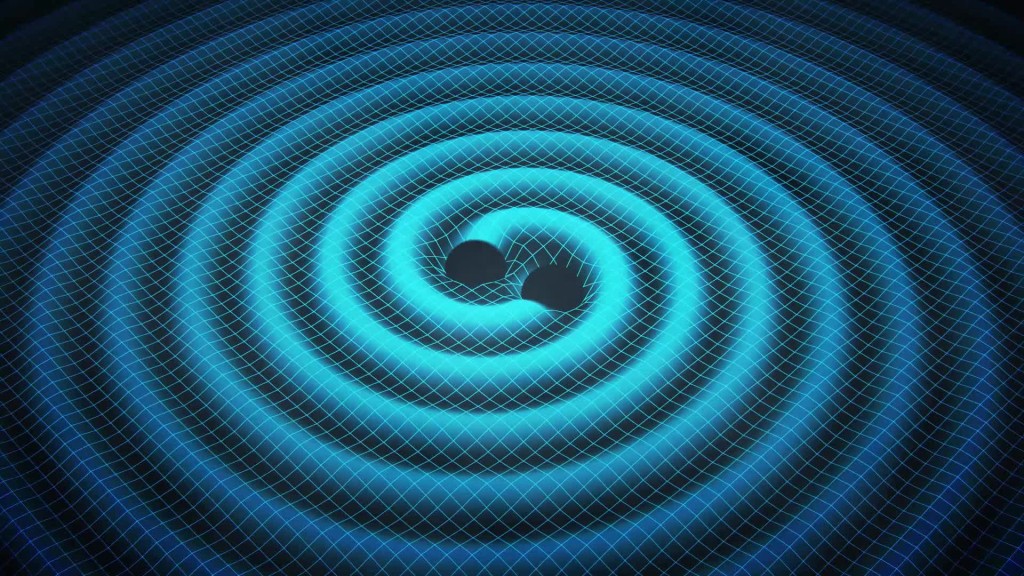Author Archive
ICTP-SAIFR organizes Workshop on Astrophysics and Relativity
Following the School on Gravitational Waves, ICTP-SAIFR organized, between the 11th and 15th of August, the Workshop on Astrophysics and Relativity. The event was attended by many students from the previous School, and brought together several international researchers from these areas. One of the main purposes of the Workshop was to build new collaborations and strengthen existing ones. Gravitational waves continued to be among the main topics, but the focus of discussions were the astrophysical bodies responsible for generating them, such as Supermassive Black Holes (SMBH), and the environment where they are situated, such as the core of galaxies.
“During the workshop, we had lectures and discussion sessions on the topics which the participants themselves elected as the most interesting”, says Riccardo Sturani, ICTP-SAIFR researcher and one of the organizers of the workshop.
Black holes
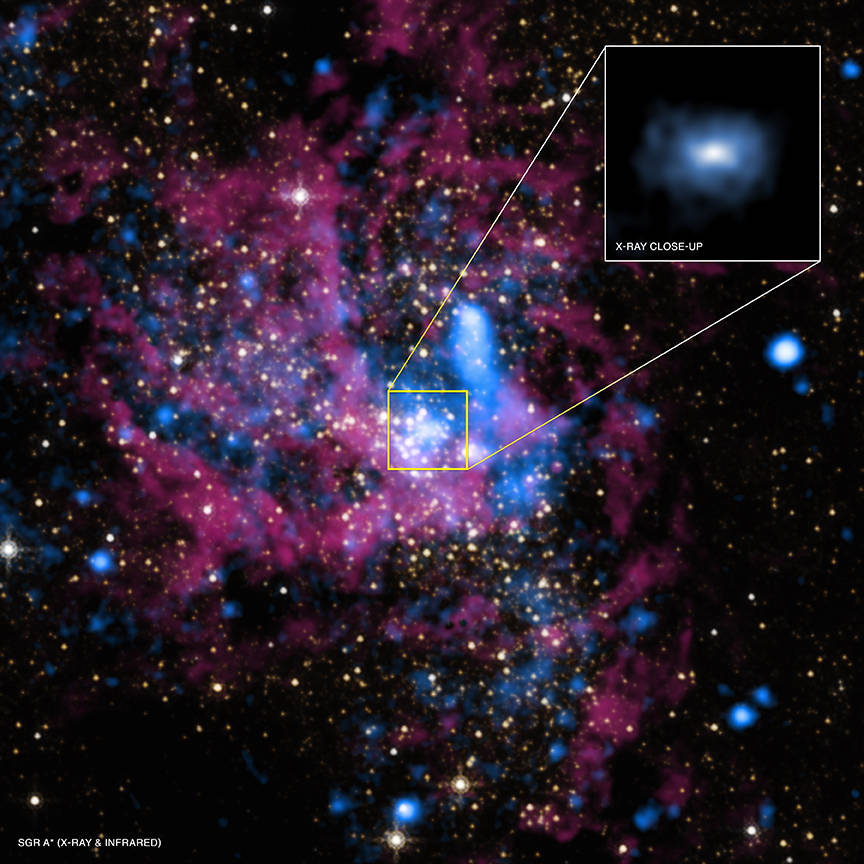
Center of the Milky Way galaxy, with the supermassive black hole Sagittarius A, located in the middle (NASA)
Black holes are regions of space characterized by a large amount of matter compressed into a small area. When its mass is of the order of thousands, or even billions of times greater than the Sun, they are called Supermassive Black Holes. Currently, it is believed that there is a SMBH at the center of all large galaxies, including the Milky Way. The study of the dynamics at the nucleus of galaxies was one of the targets of the Workshop discussions.
Research on gravitational waves was also a topic at the event. This area could contribute in the studies of black holes, as binary systems involving these astronomical bodies emit waves that could be detected directly.
To learn more about the School on Gravitational Waves, click here and read our last post.
“Black holes that are up to several hundred times larger than the sun emit gravitational waves in a frequency that can theoretically be detected in observatories on Earth”, explains Zoltan Haiman, Workshop lecturer and researcher at Columbia University.
Other topics discussed were related to the environment that allows the formation, growth and possible collisions between black holes. To Haiman, the mysteries surrounding these supermassive astronomical bodies and their relationship with the universe are alone great reasons to study the area.
“One of my main motivations to study SMBH is simply the interesting puzzle they represent”, said Haiman. “How the universe was able to compress such a large amount of matter in such a small area, for instance, is still a question for which we do not have a definitive answer”.
Continue Reading | Comments Off on ICTP-SAIFR organizes Workshop on Astrophysics and Relativity
ICTP-SAIFR organiza Workshop em Astrofísica e Relatividade
Dando continuidade à Escola em Ondas Gravitacionais, o ICTP-SAIFR organizou, entre os dias 11 e 15 de agosto, o Workshop em Astrofísica e Relatividade. O evento contou com a participação de muitos dos alunos da Escola anterior, e trouxe ainda diversos pesquisadores internacionais dessas áreas. Entre os principais objetivos do Workshop estavam formar novas colaborações e fortalecer as já existentes. Ondas gravitacionais continuaram em pauta, porém o principal foco das discussões foram os corpos astrofísicos responsáveis por gerá-las, como buracos negros supermaciços, e os ambientes onde eles são encontrados, como o núcleo de galáxias.
“Durante o Workshop, tivemos palestras e sessões de discussão sobre os temas que os próprios participantes elegeram como os mais interessantes”, diz Riccardo Sturani, pesquisador do ICTP-SAIFR e um dos organizadores do Workshop.
Buracos negros
Buracos negros são regiões do espaço caracterizadas por uma grande quantidade de matéria comprimida em uma pequena área. Quando sua massa é da ordem de milhares, podendo chegar a até bilhões, de vezes maior que a do Sol, são chamados de buracos negros supermaciços (ou SMBH, da sigla em inglês Supermassive Black Holes). Atualmente, acredita-se que há um SMBH no centro de todas as grandes galáxias, incluindo a Via Láctea. O estudo da dinâmica no núcleo de galáxias foi um dos alvos de discussões do Workshop.
A pesquisa em ondas gravitacionais também foi tópico no evento. Elas poderiam contribuir nos estudos de buracos negros já que sistemas binários envolvendo esses corpos astronômicos emitem ondas que poderiam ser detectadas diretamente.
Para saber mais sobre a Escola em Ondas Gravitacionais, clique aqui e leia nosso último post.
“Buracos negros de massa até algumas centenas de vezes maiores que a do Sol emitem ondas gravitacionais em uma frequência que, teoricamente, podemos detectar em observatórios na Terra”, explica Zoltan Haiman, palestrante do Workshop e pesquisador da Universidade de Columbia.
Outros temas abordados foram referentes aos ambientes que permitem a formação, o crescimento e possíveis colisões entre buracos negros. Para Haiman, apenas os mistérios que envolvem esses corpos astronômicos supermaciços e sua relação com o universo é estímulo suficiente para estudar a área.
“Uma das minhas principais motivações para estudar SMBH é simplesmente o interessante mistério que eles representam”, diz Haiman. “Como o universo conseguiu comprimir uma quantidade tão grande de matéria em uma região tão pequena, por exemplo, ainda é uma questão para a qual não temos uma resposta definitiva”.
Continue Reading | Comments Off on ICTP-SAIFR organiza Workshop em Astrofísica e Relatividade
ICTP-SAIFR organizes School on Gravitational Waves
In September, the LIGO (Laser Interferometer Gravitational – Wave Observatory) project will begin its experiments to detect, for the first time in a direct way, gravitational waves. Member of this international collaboration, ICTP-SAIFR researcher Riccardo Sturani was one of the organizers of the School on Gravitational Waves, held at the institute between the 3rd and 11th of August. During the event, students from several countries of South America watched lectures on this recent area of physics, that should gain more prominence in the upcoming years with the start of the LIGO activities.
“As these waves have not yet been detected directly, we have little data and few people who work with it in South America”, says Sturani. “The aim of the School was to promote the area. Through lectures, exercises and discussions, we addressed both theoretical and practical aspects, such as data analysis techniques”.
The School brought together several renowned international researchers of the area here http://samedayessays.org/essay-writer/, such as Alessandra Buonanno (Max Planck Institute, Potsdam, Germany), Stefano Foffa (University of Geneva, Italy), Sergej Klimenko (University of Florida, USA), Enrico Ramirez -Ruiz (University California-Santa Cruz, USA) and Walter Del Pozzo (University of Birmingham, UK).
Gravitational waves
All bodies that have mass generate gravitational waves when they move. These waves propagate through essay writing services space as a wave propagates in water, but are extremely weak. Only systems with large amounts of matter, such as ones consisting of black holes, for instance, can produce measurable gravitational waves. So far, its existence was confirmed only indirectly by measuring the energy emitted in the form of waves.
In a simplified way, LIGO’s idea to detect them directly is based on a system of lasers and mirrors. When passing through the system, a wave will change the amount of time a laser takes to get to a mirror, reflect and go back to a detector. Data analysis techniques for this type of experiment for buy essays online, as Sturani explains, need to be specific.
“Unlike many other areas of physics, our experiments have more noise than real signals”, says the researcher. “In my lectures, I talked about methods that can be used in such situations”.
The direct detection of gravitational waves would allow, for example, the study of astronomical bodies that don’t emit light, but emit these waves. “Our expectations is that gravitational waves will be detected by LIGO in the next two or three years”, says Sturani.
Continue Reading | Comments Off on ICTP-SAIFR organizes School on Gravitational Waves
ICTP-SAIFR realiza Escola em Ondas Gravitacionais
No mês de setembro, o projeto LIGO (Laser Interferometer Gravitational – Wave Observatory) começará seus trabalhos para tentar detectar, pela primeira vez de maneira direta, ondas gravitacionais. Membro dessa colaboração internacional, o pesquisador Riccardo Sturani, do ICTP-SAIFR, foi um dos organizadores da Escola em Ondas Gravitacionais, realizada no instituto entre os dias 3 e 11 de agosto. Durante o evento, os alunos, provenientes de diversos países da América do Sul, tiveram palestras sobre essa recente área da Física que deverá ganhar mais destaque nos próximos anos com o início das atividades do LIGO.
“Como essas ondas ainda não foram detectadas diretamente, temos poucos dados e poucas pessoas que trabalham com isso na América do Sul”, diz Sturani. “O intuito da Escola foi divulgar a área. Através de aulas, exercícios e discussões, abordamos desde aspectos teóricos até práticos, como técnicas de análise de dados”.
A Escola contou com a presença de diversos pesquisadores internacionais de ponta na área, como Alessandra Buonanno (Instituto Max Planck, Potsdam, Alemanha), Stefano Foffa (Universidade de Geneva, Itália), Sergej Klimenko (Universidade da Flórida, EUA), Enrico Ramirez-Ruiz (Universidade Califórnia-Santa Cruz, EUA) e Walter Del Pozzo (Universidade de Birmingham, Reino Unido).
Ondas Gravitacionais
Ao se moverem, todos os corpos que têm massa produzem ondas gravitacionais. Essas ondas se propagam pelo espaço assim como uma onda se propaga na água, porém são muito fracas. Apenas sistemas com grande quantidade de matéria, como aqueles constituídos por buracos negros, por exemplo, conseguem produzir ondas gravitacionais detectáveis. Até o momento, sua existência foi confirmada apenas indiretamente, pela energia que é emitida em forma de ondas.
Explicando de maneira simplificada, a ideia do LIGO para detectá-las diretamente é baseada em um sistema de lasers e espelhos. Ao passar pelo sistema, uma onda deverá alterar o tempo que um laser leva para ir até um espelho, ser refletido e voltar a um detector. As técnicas de análise de dados para esse tipo de experimento, como explica Sturani, precisam ser específicas.
“Diferente de muitas outras áreas da Física, nossos experimentos possuem mais ruídos do que sinais verdadeiros”, afirma o pesquisador. “Em minhas palestras, falei sobre métodos que podem ser utilizados em situações como essas”.
A detecção direta de ondas gravitacionais permitiria, por exemplo, o estudo de corpos astronômicos que não emitem luz, mas que emitem essas ondas. “Nossa expectativa é que ondas gravitacionais sejam detectadas diretamente pelo LIGO nos próximos dois ou três anos”, diz Sturani.
Continue Reading | Comments Off on ICTP-SAIFR realiza Escola em Ondas Gravitacionais
ICTP-SAIFR organizes School on QCD and LHC Physics
The Particle Physics area is living a year of expectations with the start of the second run of the Large Hadron Collider (LHC), the largest particle accelerator in the world. In addition to study further the Higgs Boson, one of the main goals of the LHC is to detect new particles, which would mean the existence of a Physics beyond the Standard Model. These were some of the reasons why ICTP-SAIFR held the “School on QCD and LHC Physics“. Between July 22nd and 31nd, the event discussed topics related to the field of Quantum Chromodynamics and Particle Physics. The School was proposed and organized by important names of these fields, such as David Kosower (Saclay), Daniel de Florian (Universidad de Buenos Aires), Fernando Cordero (University of Freiburg) and Rogério Rosenfeld (ICTP-SAIFR).
“One of the merits of the School was to bring together top scientists from around the world to talk about their specialties”, says Gavin Salam, CERN researcher and one of the lecturers of the event.
QCD
Quantum Chromodynamics, or QCD, studies the phenomena related to the Strong Force – responsible for the interactions between quarks and gluons. The area is called QCD due to the fact that these particles have a property, similar to electric charge, that instead of two types (positive and negative) is observed in three types – which were denominated red, green and blue.
“QCD has been around for about 40 years, but there was a huge growth of interest in this area in the last decade”, says Salam. “The LHC and their findings provided great motivation for studies in QCD. My lectures introduced the main ideas related to this area and to the physical principles and processes of the interactions between quarks and gluons”.
Moreover, Salam stressed that studies in QCD are also related to other areas of physics. “The mathematics involved in these researches can be applied to Field Theory, for example. So contributions in one of these areas may have significant impact on the studies of the other”.
LHC
“The LHC works as an extremely powerful microscope,” says Kosower.
By colliding protons, the particle accelerator allows studies on scales thousands of times smaller than the atom. Understanding what happens in these collisions, however, requires complex calculations. Increasing the accuracy of these calculations, which are often based in approximations, is one of the challenges of Kosower’s area. The physicist, recipient of the J. J. Sakurai Prize for Theoretical Particle Physics in 2014, made significant contributions to the area and spoke about Higher-Order Calculations at the School.
“We aim to make predictions about the probabilities of certain events occurring after the collisions and to better understand what happens in this subatomic universe,” he said.
In this second run, one of LHC’s major goals is to study the Higgs Boson in greater detail. “In the first run of LHC experiments, our calculations were limited because of statistics – few Higgs Bosons were produced. Now, with increased power and luminosity, the LHC will be able to produce and detect a much larger amount of Bosons, which will allow more detailed studies of this particle”.
Among other objectives of the LHC is to discover new particles, not predicted by the Standard Model. If this happens, it would mean the existence of a Physics beyond the Standard Model.
“The most interesting and exciting result, in my opinion, would be the discovery of something new, not predicted,” says Kosower. “But for now, we can’t know what will happen. Maybe new particles will be detected, maybe not. With a record energy of 13TeV, we will be looking at a so far unknown territory”.
Continue Reading | Comments Off on ICTP-SAIFR organizes School on QCD and LHC Physics
ICTP-SAIFR realiza Escola em Física do LHC e QCD
A área de Física de Partículas vive um ano de expectativas com o início da nova etapa de coleta de dados do Large Hadron Collider (LHC), maior acelerador de partículas do mundo. Além de aprofundar os estudos sobre o Bóson de Higgs, o LHC tem como um de seus objetivos detectar uma nova partícula, o que significaria a existência de uma Física além do Modelo Padrão. Esses foram alguns dos motivos pelos quais o ICTP-SAIFR realizou a “School on QCD and LHC Physics”. Entre os dias 22 e 31 de julho, o evento debateu tópicos relacionados ao campo da Cromodinâmica Quântica e à Física de Partículas do LHC. A Escola foi proposta e organizada por importantes nomes dessas áreas, como David Kosower (Saclay), Daniel de Florian (Universidad de Buenos Aires), Fernando Cordero (Universidade de Freiburg) e Rogério Rosenfeld (ICTP-SAIFR).
“Um dos méritos da Escola foi reunir cientistas de ponta do mundo inteiro para falar sobre suas especialidades”, diz Gavin Salam, pesquisador do CERN e palestrante do evento.
QCD
A área chamada de Cromodinâmica Quântica (ou QCD, da sigla em inglês Quantum Chromodynamics) estuda os fenômenos relacionados à Força Forte – aquela responsável pelas interações entre quarks e glúons. Ela é chamada assim devido a uma característica dessas partículas, similar à carga elétrica, que em vez de dois tipos (positivo e negativo), é observada em três tipos – denominados vermelho, verde e azul.
“A QCD existe há cerca de 40 anos, porém houve um grande crescimento de interesse nessa área na última década”, afirma Salam. “O LHC e suas descobertas forneceram uma grande motivação para os estudos em QCD. Minhas palestras introduziram as principais ideias relacionadas a essa área e aos processos e princípios físicos das interações entre quarks e glúons”.
Além disso, Salam ressaltou que estudos em QCD estão relacionados também com outras áreas da Física. “Ás vezes, a matemática envolvida nessas pesquisas pode ser aplicada em Teoria dos Campos, por exemplo. Assim, descobertas em uma dessas áreas podem dar contribuições significativas para os estudos da outra”.
LHC
“O LHC funciona para nós como um microscópio extremamente potente”, diz Kosower.
O acelerador de partículas, ao colidir prótons, permite o estudo de partículas em escalas milhares de vezes menores do que a do átomo. Entender o que acontece nessas colisões, entretanto, requer cálculos complexos. Aumentar a precisão desses cálculos, feitos muitas vezes baseados em aproximações, é um dos desafios da área de Kosower. O físico, vencedor do Prêmio J. J. Sakurai para Física de Partículas Teórica em 2014, fez contribuições significativas para a área e falou sobre Cálculos de Ordem Superior na Escola.
“Buscamos fazer previsões sobre as probabilidades de determinados eventos ocorrerem após as colisões e entender melhor o que acontece nesse universo subatômico”, disse ele.
Nessa segunda etapa de coleta de dados, um dos principais objetivos do LHC é aprofundar os estudos sobre o Bóson de Higgs, descoberto pelo acelerador em 2012. “Na primeira fase de experimentos do LHC, nossos estudos ficaram limitados por conta da estatística – conseguimos produzir poucos Bósons de Higgs. Agora, com maior energia e luminosidade, o LHC irá produzir e detectar uma quantidade muito maior de Bósons, o que permitirá estudos mais detalhados dessa partícula”.
Entre outros objetivos do LHC está descobrir novas partículas, não previstas pelo Modelo Padrão. Caso aconteça, isso significaria a existência de uma Física além do Modelo Padrão.
“O resultado mais interessante e mais empolgante, na minha opinião, seria a descoberta de algo novo, não previsto”, diz Kosower. “Mas, por enquanto, não há como saber o que irá acontecer. Talvez nenhuma nova partícula seja descoberta, talvez sim. Com a energia recorde do LHC de 13TeV, vamos olhar para um território até agora desconhecido”.
Continue Reading | Comments Off on ICTP-SAIFR realiza Escola em Física do LHC e QCD
Colloquium discusses String Theory and F Theory
In June, the weekly colloquium held at ICTP-SAIFR received Mirjam Cvetic, from the University of Pennsylvania, United States. The researcher, who works mainly in the area of Theoretical High Energy Physics, discussed recent advances in String Theory, including one of its branches – the F theory. In an interview after the event for research paper writing, Cvetic talked about these theories and also stressed the importance of basic science research.
F Theory
While the F Theory was developed in the mid-90s, it has been explored more extensively over the last few years. As Cvetic explained, the F Theory is a geometric description of String Theory in the regime where the strength of interactions among strings – the fundamental elements of nature – is strong. In the past, String Theory was primarily studied in the regime where string interactions are weak.
“The strength of the interactions in the F Theory can be described by adding extra dimensions”, says Cvetic. “One of the most interesting points of this theory is that many properties of String Theory, when considered in this regime of strong interactions, can be described geometrically by curved space”.
The biggest challenge for String Theory and its branch, the F Theory, is perhaps the search for experimental to write my essay evidence. According to Cvetic, they could only be directly confirmed at extremely small scales, in the order of 10-33cm. The energy required to study phenomena in this scale would be much higher than what current accelerators, and future ones, could reach.
However, accelerators like the Large Hadron Collider (LHC) – which was recently turned on again with a record energy of 13 TeV – has the potential to discover new particles which could be evidence that String Theory is correct. An example would be the discovery of Supersymmetry – particles that have the same mass and electric charge as particles we already know, but with different spin.
Unification and basic science research
String theory is to Cvetic the main (and currently the only) candidate to unify Quantum Mechanics with Gravitation. “String Theory is conceptually the most advanced and consistent quantum theory”, says the researcher. “Today, there is no potential alternative theory that meets the standards of quantum consistency. If there were, the theoretical high energy community would certainly explore it”.
Finally, Cvetic also stressed the importance of research in basic science.
“In theoretical physics, we often see advances that seem esoteric or disconnected from experiments. However, it is important to support efforts in basic science. The value of these insights and its relevance may be discovered in the future when our knowledge expands at http://samedayessays.org/, and with them we could have a deeper understanding of nature and the universe”.
Continue Reading | Comments Off on Colloquium discusses String Theory and F Theory
Colóquio discute Teoria das Cordas e Teoria F
No mês de junho, o Colóquio semanal realizado pelo ICTP-SAIFR recebeu Mirjam Cvetic, da Universidade de Pensilvânia, nos Estados Unidos. A pesquisadora, que trabalha principalmente na área de Física Teórica de Altas Energias, discutiu avanços recentes em Teoria das Cordas, incluindo uma de suas ramificações – a Teoria F. Em entrevista após o evento, Cvetic falou mais sobre essas teorias e ressaltou também a importância da pesquisa básica.
Teoria F
A Teoria F foi desenvolvida na metade da década de 90 e foi explorada mais extensivamente ao longo dos últimos anos. Como explicou Cvetic, A Teoria F é uma descrição geométrica da Teoria das Cordas, onde a força de interação entre as cordas – elementos fundamentais da natureza – é forte. No passado, a Teoria das Cordas era estudada principalmente em um regime onde essa interação é fraca.
“A força das interações na Teoria F pode ser descrita acrescentando dimensões extras”, diz Cvetic. “Um dos pontos mais interessantes dessa teoria é que muitas das propriedades da Teoria das Cordas, quando consideradas nesse regime de interações fortes, podem ser descritas geometricamente pela curvatura do espaço”.
O maior desafio para ambas as teorias talvez seja a busca por evidências experimentais. Segundo Cvetic, elas poderiam ser diretamente confirmadas apenas em escalas extremamente pequenas, da ordem de 10-33 centímetros. A energia necessária para estudar fenômenos nessa escala seria muito maior do que a que aceleradores atuais, e futuros, poderiam atingir.
Entretanto, aceleradores como o Large Hadron Collider (LHC) – que foi ligado recentemente em uma energia recorde de 13 TeV – poderiam descobrir novas partículas que serviriam como evidências favoráveis à Teoria das Cordas. Um exemplo seria a descoberta de Supersimetria, ou seja, de partículas que possuem a mesma massa e carga elétrica de partículas que já conhecemos, porém com spin diferente.
Unificação e pesquisa básica
A Teoria das Cordas é, para Cvetic, a principal (e única atualmente) candidata para unificar a Mecânica Quântica com a Gravitação. “A Teoria das Cordas é a mais avançada conceitualmente e a mais consistente”, diz a pesquisadora. “Hoje, não há nenhuma outra alternativa em potencial à altura dos padrões de consistência quânticos. Se existisse, a comunidade científica iria, sem dúvida, explorá-la”.
Ao final, Cvetic também ressaltou a importância da pesquisa em ciência básica.
“Em Física Teórica, muitas vezes vemos avanços que parecem esotéricos ou desconectados de experimentos. Porém, é importante apoiar esforços em ciência básica. O valor desses conhecimentos e sua relevância podem ser descobertos no futuro, quando nossa compreensão for maior, e com eles poderemos entender melhor como funcionam o universo e a natureza”.
Continue Reading | Comments Off on Colóquio discute Teoria das Cordas e Teoria F
IFT hosts XXIX Jornada de Física Teórica
IFT/UNESP hosted, between July 13th and 17th, the twenty-ninth edition of the Jornada de Física Teórica (JFT). The traditional activity, held annually since 1986, aims to discuss the main research areas of the Institute with students who are in the last years of their graduation or in the beginning of their masters. This way, students from universities from all Brazil, and in some cases from other countries of South America, can learn more about the postgraduate programs of IFT and learn about current topics in Physics.
“Throughout the week, five IFT researchers teach mini-courses in their specialties,” says Ricardo D’Elia Matheus, organizer of the JFT. “So in addition to putting students in touch with our research areas, we introduce information about new topics for them in an understandable way to everyone”.
Frequent themes in JFT include Particle Physics, String Theory and Field Theory, some of the main research areas of IFT. This year, JFT also featured courses on Relativity and Quantum Mechanics and, for the first time, on Gravitational Waves.
Gravitational waves
The classes on Gravitational Waves were given by ICTP-SAIFR’s Young Researcher Riccardo Sturani. These waves are generated by any body that has mass and is in accelerated motion, but are extremely weak. In order to have measurable effects, they need to be produced by systems with a large amount of mass, such as black holes or neutron stars. Despite having been detected indirectly, no observatory was able to detect them in a direct way so far.
“During the course, my focus was on how to apply Field Theory specifically for the study of Gravitational Waves,” Sturani said. “Some observatories will try to detect these waves directly in the upcoming years, such as those involved in the LIGO collaboration, which I’m a part of. Gravitational waves enables, for example, the study of astrophysical bodies which emit no light, but that emit these waves”.
Future editions
For those interested in participating in future editions, the registration period usually takes place in May and is published in the IFT website and on the Institute’s Facebook page. Among the selection criteria are curriculum analysis and academic performance. The event is supported by the IFT Foundation and provides lodging assistance for some of the selected students.
Continue Reading | Comments Off on IFT hosts XXIX Jornada de Física Teórica
IFT realiza XXIX Jornada de Física Teórica
O IFT/Unesp realizou, entre os dias 13 e 17 de julho, a vigésima nona edição da Jornada de Física Teórica (JFT). A tradicional atividade, realizada anualmente desde 1986, tem como um de seus principais objetivos divulgar as mais importantes áreas de pesquisa do instituto para alunos que estão nos últimos anos de graduação ou no início do mestrado. Dessa maneira, estudantes provenientes de universidades de todo o Brasil, e em alguns casos de outros países da América do Sul, podem conhecer mais sobre os programas de pós-graduação do IFT e aprender sobre temas atuais em Física.
“Ao longo da semana, cinco professores do IFT ministram mini-cursos em suas especialidades”, diz Ricardo D´Elia Matheus, organizador da JFT. “Assim, além de colocar os alunos em contato com nossas linhas de pesquisa, apresentamos conhecimentos sobre assuntos novos para eles e de maneira compreensível a todos”.
Temas frequentes nas JFT incluem Física de Partículas, Teoria das Cordas e Teoria de Campos, áreas de destaque do IFT. Esse ano, a Jornada também contou com cursos sobre Relatividade e Mecânica Quântica e, pela primeira vez, sobre Ondas Gravitacionais.
Ondas Gravitacionais
As aulas sobre Ondas Gravitacionais foram dadas pelo Jovem Pesquisador do ICTP-SAIFR Riccardo Sturani. Essas ondas são geradas por qualquer corpo que tenha massa e que esteja em movimento acelerado, porém são extremamente fracas. Para terem efeito mensurável, precisam ser produzidas por sistemas com grande quantidade de massa, como os de buracos negros ou de estrelas de nêutron. Apesar de já terem sido detectadas indiretamente, nenhum observatório conseguiu detectá-las de maneira direta até agora.
“Durante o curso, quis transmitir para os alunos como aplicar a Teoria de Campos especificamente para o estudo de ondas gravitacionais”, disse Sturani. “Há observatórios que tentarão detectar essas ondas diretamente nos próximos anos, como os relacionados à colaboração LIGO, da qual faço parte. Ondas gravitacionais permitiriam, por exemplo, observar corpos no espaço que não emitem luz, mas que emitem essas ondas”.
Próximas edições
Para quem tiver interesse em participar das próximas edições, o período de inscrição geralmente ocorre em maio e é divulgado pelo site do IFT e pela página do instituto no Facebook. Entre os critérios de seleção estão análise de currículo e desempenho acadêmico. O evento possui apoio da Fundação IFT e oferece auxílio hospedagem para alguns dos alunos selecionados.
Continue Reading | Comments Off on IFT realiza XXIX Jornada de Física Teórica
